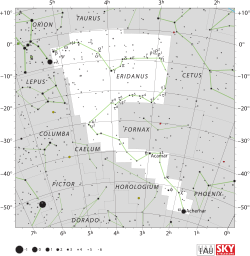HD 24160
| HD 24160 | |
 | |
| Observationsdata Epok: J2000.0 | |
|---|---|
| Stjärnbild | Eridanus |
| Rektascension | 03t 49m 27,24527 s[1] |
| Deklination | -36° 12′ 34,8771 ″[1] |
| Skenbar magnitud () | +4,17 (V)[2] |
| Stjärntyp | |
| Spektraltyp | G7 III[3] |
| B–V | +0,927 ± 0,045[2] |
| Astrometri | |
| Radialhastighet () | +2,0 ± 0,7[4] km/s |
| Egenrörelse (µ) | RA: -44,841[1] mas/år Dek.: -50,421[1] mas/år |
| Parallax () | 15,0389 ± 0,2211[1] |
| Avstånd | 217 ± 3 lå (66,5 ± 1,0 pc) |
| Absolut magnitud () | +0,13[2] |
| Detaljer | |
| Massa | 2,33[5] M☉ |
| Radie | 11[6] R☉ |
| Luminositet | 81,3[5] L☉ |
| Temperatur | 4 948 ± 45[5] K |
| Metallicitet | +0,08 ± 0,02 (Fe/H) [7] dex |
| Ålder | 1,76[5] miljarder år |
| Andra beteckningar | |
| g Eri, CD-36 1467, CPD-36 415, FK5 143, GSC 07035-01374, HD 24160, HIC 17874, HIP 17874, HR 1195, IRAS 03475-3621, 2MASS J03492725-3612007, PLX 845, PPM 279496, SAO 194559, TD1 2592, TYC 7035-1374-1, Gaia DR2 4858358982512866432 [8][9] | |
HD 24160 är en ensam stjärna[10] i den mellersta delen av stjärnbilden Eridanus som också har Bayer-beteckningen g Eridani. Den har en skenbar magnitud av ca 4,17[2] och är svagt synlig för blotta ögat där ljusföroreningar ej förekommer. Baserat på parallax enligt Gaia Data Release 2 på ca 15,0[1] mas, beräknas den befinna sig på ett avstånd på ca 217 ljusår (ca 67 parsek) från solen. Den rör sig bort från solen med en heliocentrisk radialhastighet på ca 2 km/s.[4] Stjärnan ingår i Ursa Major rörelsegrupp av stjärnor med gemensam rörelse genom rymden.[11]
Egenskaper
[redigera | redigera wikitext]HD 24160 är en gul till orange jättestjärna av spektralklass G7 III,[3] som har förbrukat förrådet av väte i dess kärna och rört sig bort från huvudserien. Den har en massa som är ca 2,3[5] solmassor, en radie som är ca 11[6] solradier och har ca 81 gånger solens utstrålning av energi[5] från dess fotosfär vid en effektiv temperatur av ca 4 900 K.[5]
Referenser
[redigera | redigera wikitext]- Den här artikeln är helt eller delvis baserad på material från engelskspråkiga Wikipedia, HD 24160, 26 juni 2021.
Noter
[redigera | redigera wikitext]- ^ [a b c d e f] Brown, A. G. A.; et al. (Gaia collaboration) (August 2018). "Gaia Data Release 2: Summary of the contents and survey properties". Astronomy & Astrophysics. 616. A1. arXiv:1804.09365. Bibcode:2018A&A...616A...1G. doi:10.1051/0004-6361/201833051.
- ^ [a b c d] Anderson, E.; Francis, Ch. (2012), "XHIP: An extended hipparcos compilation", Astronomy Letters, 38 (5): 331, arXiv:1108.4971, Bibcode:2012AstL...38..331A, doi:10.1134/S1063773712050015, S2CID 119257644.
- ^ [a b] Keenan, Philip C.; McNeil, Raymond C. (1989), "The Perkins catalog of revised MK types for the cooler stars", Astrophysical Journal Supplement Series, 71: 245, Bibcode:1989ApJS...71..245K, doi:10.1086/191373.
- ^ [a b] de Bruijne, J. H. J.; Eilers, A.-C. (October 2012), "Radial velocities for the HIPPARCOS-Gaia Hundred-Thousand-Proper-Motion project", Astronomy & Astrophysics, 546: 14, arXiv:1208.3048, Bibcode:2012A&A...546A..61D, doi:10.1051/0004-6361/201219219, S2CID 59451347, A61.
- ^ [a b c d e f g] Luck, R. Earle (2015), "Abundances in the Local Region. I. G and K Giants", Astronomical Journal, 150 (3), 88, arXiv:1507.01466, Bibcode:2015AJ....150...88L, doi:10.1088/0004-6256/150/3/88, S2CID 118505114.
- ^ [a b] Pasinetti Fracassini, L. E.; et al. (February 2001), "Catalogue of Apparent Diameters and Absolute Radii of Stars (CADARS) - Third edition - Comments and statistics", Astronomy and Astrophysics, 367 (2): 521–524, arXiv:astro-ph/0012289, Bibcode:2001A&A...367..521P, doi:10.1051/0004-6361:20000451, S2CID 425754.
- ^ Alves, S.; et al. (April 2015), "Determination of the spectroscopic stellar parameters for 257 field giant stars", Monthly Notices of the Royal Astronomical Society, 448 (3): 2749–2765, arXiv:1503.02556, Bibcode:2015MNRAS.448.2749A, doi:10.1093/mnras/stv189.
- ^ HD 24160 (u-strasbg.fr) |Hämtad 2022-01-15.
- ^ "HD 24160". SIMBAD. Centre de données astronomiques de Strasbourg. Hämtad 2018-07-23.
- ^ Eggleton, P. P.; Tokovinin, A. A. (2008), "A catalogue of multiplicity among bright stellar systems", Monthly Notices of the Royal Astronomical Society, 389 (2): 869, arXiv:0806.2878, Bibcode:2008MNRAS.389..869E, doi:10.1111/j.1365-2966.2008.13596.x, S2CID 14878976.
- ^ Chupina, N. V.; et al. (June 2006), "Kinematic structure of the corona of the Ursa Major flow found using proper motions and radial velocities of single stars", Astronomy and Astrophysics, 451 (3): 909–916, Bibcode:2006A&A...451..909C, doi:10.1051/0004-6361:20054009.
Externa länkar
[redigera | redigera wikitext]Text is available under the CC BY-SA 4.0 license; additional terms may apply.
Images, videos and audio are available under their respective licenses.





